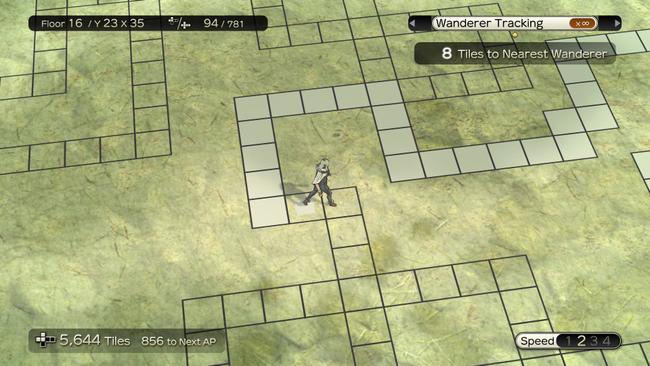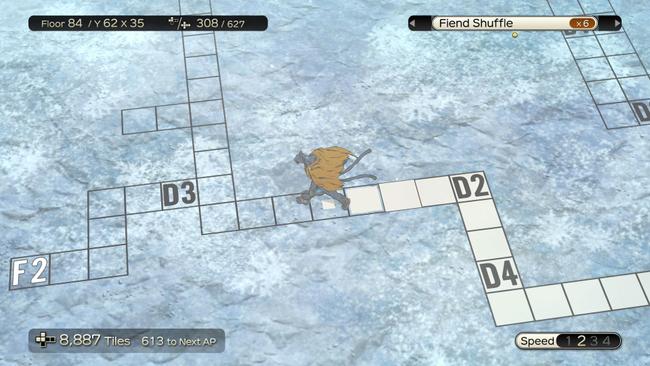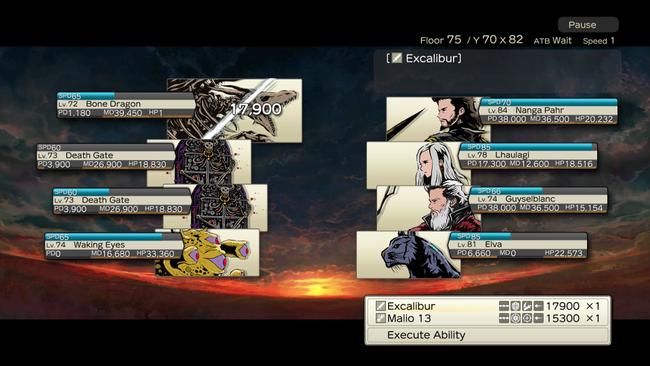
Dungeon Encounters Review
Ever since directing Final Fantasy IX and taking over for Final Fantasy XII, not much has been seen of Hiroyuki Ito in the last decade or so. Known for his seminal gameplay design concepts and conceiving long-lived battle mechanics such as Active-Time-Battle (ATB) all the way back in 1991 for Final Fantasy IV, it's easy to declare Ito as simply one of the most influential game designers of the genre.
Ito is somewhat of an unsung founding father of the Final Fantasy series, being more technically-minded and placing gameplay over narrative, whose own stated philosophy is to incorporate game concepts so smoothly that narrative designers can focus on story elements without worrying about how the game will play alongside.
After such a long absence, it was quite a surprise to see Ito make a rare appearance during Square Enix's Tokyo Game Show stream event earlier this year. Here he announced minimalist ATB RPG Dungeon Encounters, which would be released only a few weeks later. Eschewing storylines & character arcs for battles & numbers, Dungeon Encounters is an interesting little project from one of the all-time genre greats.

The great thing about the RPG genre (and why we at RPG Site are drawn to them, of course) is that their multifaceted nature often has something for everyone. Some RPGs have deep stories or captivating characters, some have beautiful worlds to explore and get lost in, some have cool combat, customization, or progression systems. Different sorts of players may latch onto different components of an RPG completely, and they might adore it all the same.
That said, Dungeon Encounters is a very specific type of RPG for a very specific type of RPG player. It strips what we know as an 'RPG' to some of its barest but most-crucial components. Gone are overwrought narratives, lengthy bouts of dialogue, intricate cutscenes, vast landscapes, and the like. Instead, we have deceptively simple battles and satisfying dungeon traversal. That's it.
Dungeon Encounters has a sort of narrow appeal in what I like to call a 'glove game'. If its style (the metaphorical 'glove') fits your tastes and is what you are looking for in an RPG, it could be absolutely perfect for you to wear. But if it doesn't fit for you, it could be worthless in your eyes, despite being a well-made glove otherwise.
Bluntly put, if you come to the RPG genre primarily seeking out fun characters and storylines, you're best suited to look elsewhere. But if you are a numbers nerd or a game mechanics gearhead (like me), you might want to give Dungeon Encounters some consideration.
In Dungeon Encounters, after an exceedingly brief introductory text, you take a team of travelers from an academy to explore the depths of some dungeon locales. There otherwise is no story in the game, outside of some flavor text you'll find in the menu. The 'dungeons' in this case are effectively stylized as bits & pieces of graph paper, in which you move from tile to tile with your primary goal to reach every spot on each floor before moving on to the next one. With 100 floors in total, the premise of Dungeon Encounters is simple.

The game can kinda be described as a third-person Wizardry, only even simpler in a way. There are no job classes or stat allocation or anything like that. For the most part, characters are effectively interchangeable and are only defined by the weapons and equipment you give them. However, there are a few weapons that can only be used by certain characters, such as the 'Meowitzer' which can only be used by Sir Cat (who is a big cat), which is about the only place where some characters can be differentiated from each other.
Dungeon Encounters does have towns, shops, and such, but they only exist represented as numbers on the spreadsheet-like dungeon. As you run along each floor filling out each tile, you'll occasionally run into weapon merchants, places to heal, and places to set your team skills, but each is as simple as they come: a menu. Of course, you'll run into numerous battles as well, also represented on the map as a number.
The combat is a turn-based system rooted in ATB, of course. Your four characters will take on many, many battles against all sorts of foes on each floor of the dungeon. How combat works in Dungeon Encounters is basically like this: each participant in battle has three meters - Physical Defense (PD), Magic Defense (MD), and Health Points (HP). Every attack in the game is either Physical or Magical and will deal damage to a unit's PD or MD, respectively. Once their defense is down, you can deal damage to HP in aim to take out your foes.
Combat is simple on paper but more subtle depth comes in its execution. Some types of enemies can only be hit by certain types of weapons. Some enemies might have much higher PD or MD, coercing the player to focus on using certain types of attacks in order to remain efficient. Some weapons do more randomized damage while some weapons will always do a specified amount of damage each time it is used. Various status effects will come into play as well.

Importantly, PD/MD will restore after every battle, while HP will not. So if you can manage to minimize HP damage as you trek through the floors, you might be able to go for quite a while before needing to find a place to heal. Healing comes at a bit of a premium in Dungeon Encounters, so one of your primary goals should be to minimize damage taken as much as possible.
While the dungeon layouts start pretty simple, they ultimately become quite devious as you progress through the game. Straightforward paths become more labyrinthian, pitfalls & other traps begin to appear, and later floors have invisible paths & other tricky-to-navigate layouts.
You also gain more and more skills that can be used both inside and outside of battle as you proceed through Dungeon Encounters. Some of these skills allow you to move around a bit more fluidly, either skipping over gaps or even skipping a floor entirely. Some skills are more useful in combat, such as being able to heal or revive party members. Other skills might allow you to find new characters wandering around the map that you can use in battle.
About halfway through the game, dungeon traversal takes quite a big change, as you begin to gain skills that allow you to skip multiple floors entirely, at the risk of now running into much stronger enemies on higher floors. However, you might be able to earn some great equipment on later floors, making the risk of jumping around the dungeon worth it.
The key point I want to emphasize about Dungeon Encounters is that everything just feels very tight-knit and well-crafted. There is almost no unneeded fluff in any regard, and every component in the game has a specific purpose to being there. Gameplay is otherwise quite snappy, too, so it's easy to get into a rhythm in learning how everything works and what you need to do. Ito has shown that, somehow, he has a knack for polishing this sort of gameplay design and he distills almost everything in just the right way.
Despite being a different sort of game, Hiroyuki Ito's philosophy behind Dungeon Encounters is somewhat reminiscent of Akitoshi Kawazu's philosophy with SaGa Scarlet Grace: Ambitions, which also decided to boil down what the creator considered essential to the genre, only focusing more on battles and less on dungeons in SaGa's case. (For those keeping score, we gave Scarlet Grace a 10/10 review and awarded it our best RPG of 2019 - it's pretty good!)

When it comes to gameplay balance, Dungeon Encounters is also usually good, but not always. A persistent level of challenge is often maintained throughout, while typically never feeling too tough to overcome with good strategies and some planning. Sometimes you might find yourself facing a party-wipe, though, which in true dungeon crawler fashion means you'll have to rescue your downed team with another set of explorers from the academy. Despite this, Dungeon Encounters usually doesn't feel unfair.
However, since your party's damage output is solely determined by which weapons you have outfitted on your characters, occasionally you may find yourself severely underpowered simply because you weren't lucky enough to get upgraded weapons to randomly drop from battle. A single weapon drop or two can considerably affect your team's combat potential, which unfortunately means that sometimes you'll be at the mercy of RNG as you wait for stronger equipment to fall into your lap.
Dungeon Encounters does have a system in place to combat this somewhat: shop selection will improve over time as you progress further and further into the game, so you'll at least be able to purchase better weapons *eventually*, but these are usually not as immediately available and sometimes not as good, which kinda makes it more like a consolation prize. I wish there was maybe something else in place to not have so much emphasis placed on weapon drops from enemies, but maybe that would take away from the minimalist nature of the game itself.

One other component to Dungeon Encounters that I was immediately at odds with, unfortunately, was its music. Specifically, its battle music. I'm sorry Uematsu, but in a game where you are going to be spending the majority of your time in combat encounters, squawky guitar renditions of classical music aren't really what I want to listen to on repeat. Tastes are tastes of course, but I decided to mute Dungeon Encounters in favor of my own music or podcasts. It is what it is, sadly.
I'm glad Dungeon Encounters exists. It falters in a few ways and it is definitely not for everyone, but overall it offers a satisfying dungeon crawler with simple rules, subtle depth, and just enough teeth to remain engaging.